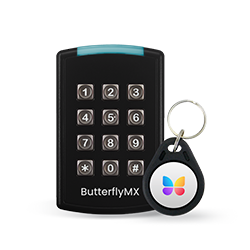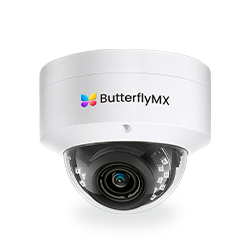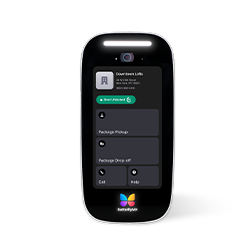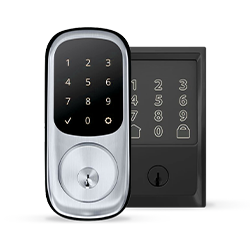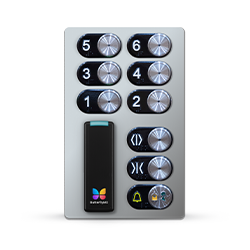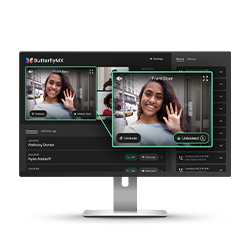Key takeaways
- Door access control systems utilize a control panel, credential, reader, and release mechanism.
- The two main door access control system types include cloud-based and network or legacy systems.
- Multi-door access control systems are designed for larger properties with multiple access points. In contrast, single-door access control systems are best for small businesses with one or a few doors.
- Choose a door access control system based on weatherproofing, scalability, cloud-based infrastructure, and installation complexity.
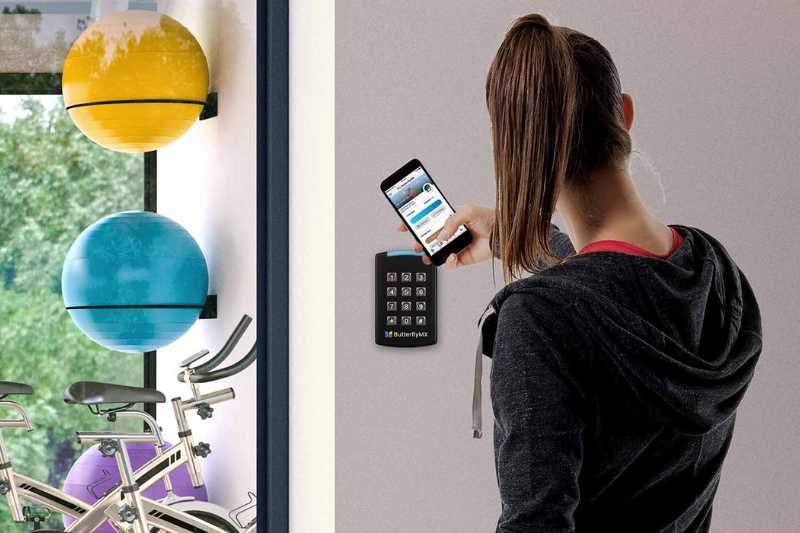
Keeping your property safe and secure requires a lot of foresight. However, adding a door access control system simplifies the process. The proper access control system enhances security and adds convenience for both your tenants and property staff.
So, this blog will detail everything you need to know about the best access control systems on the market. Additionally, you’ll discover how door access control systems work, the differences between single- and multi-door systems, and what to consider when choosing a solution for your property.
This post covers:
- How does a door access control system work?
- Door access control use cases
- How to choose the right access control system
- What are the four major types of door access control systems?
- Comparing single-door vs. multi-door access control systems
- Choosing the door access control system that works for your property
- Door access control system FAQs
More than 40K, 5-star reviews!
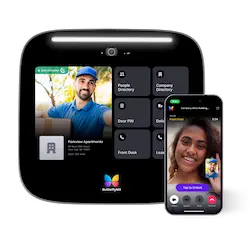
Video Intercoms
Open doors, gates & garages from anywhere.
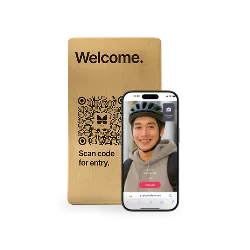
QR Code Intercom
Smartphone-based visitor access.
Access Control
Fob, key cards, PINs, and mobile apps.
Security Cameras
Visibility throughout your property.
Vehicle Access
Hands-free access for gates & garages.
Package Room
Receive, store, and manage deliveries.
Smart Locks
Connect to all major brands and models.
Elevator Controls
Unlock key-fobbed elevators for anyone.
Front Desk Station
See all your doors and cameras in one place.
How does a door access control system work?
How door access control works depends on the type of system you choose. If you use an electronic or mechatronic door access system, you’re on your way to future-proofing your property. You can also rest assured knowing that the building’s security system is robust.
Furthermore, the way a multi-door access control system works differs a bit between systems. Nonetheless, there are foundational components of almost every electronic door access control system.
The four main components of a door access control system are:
Access control panel
The access control panel – or access control door controller – is the system’s brain. It comes in a physical device or cloud-based software that can be managed wirelessly from anywhere with internet access.
The access control panel contains tenant and staff information that the property owner or manager configures. If the access credentials match the information in the database, then the access control panel signals the door to open.
Access credentials
Access credentials are linked to every user and contain information about each person’s access permissions. They can come in one or more forms depending on the level of security you want in your building.
Common types of door access credentials are:
- Key cards or fobs
- PIN codes
- Mobile app
- Biometrics
Credential reader
The credential reader receives an encrypted tag number when someone scans their credentials. Then, the door access card reader system sends that information to the access control panel to decode.
The access control panel compares it to the information in the system database. Then, if the information matches up, the system signals the door release to activate.
Door release mechanism
After the control panel authenticates the credentials, it signals the door to unlock. This happens automatically through either an electronic or magnetic door lock release mechanism.
Learn how the ButterflyMX Access Control platform works:
Door access control use cases
A modern door access control system enhances security, convenience, and operational efficiency across various property types.
Here are specific use cases for door access control:
Multifamily buildings
- Challenge. Traditional keys and fobs are costly to replace, and managing access for residents, guests, and service providers is time-consuming.
- Solution. A cloud-based access control system with mobile credentials allows residents to enter with their smartphones, eliminating lost key issues. Property managers can remotely grant or revoke access, issue temporary visitor passes, and integrate with video intercoms to verify guests before entry.
Office buildings
- Challenge. Businesses need to control who can access certain areas while allowing seamless entry for employees and visitors.
- Solution. A mobile or key card-based access system ensures that only authorized personnel enter restricted areas. Time-based access rules can automatically grant entry to cleaning crews or maintenance staff during set hours. Cloud-based systems enable HR teams to update permissions remotely when employees join or leave.
Commercial properties
- Challenge. Retail stores, warehouses, and commercial spaces are vulnerable to theft, especially outside business hours.
- Solution. Access control systems integrated with security cameras provide real-time entry logs and visual verification of who enters. Employees can be assigned specific access levels to restrict entry to inventory storage or cash-handling areas.
How to choose the right access control system
Invest in a robust door access control system to protect your tenants, staff, and property. While there are many commercial and apartment access control solutions to choose from, not all will check every box.
When it comes to choosing a door access control solution, here is what to look for:
- On-premise vs. cloud-based. Choose between an on-site system that requires on-premise servers or a cloud-based solution that uses the internet to store data. Cloud-based access control is preferred for most because they require less wiring, have lower installation costs, and receive remote updates, extending their lifespan.
- Installation. Choose a system that is easy to install and doesn’t require large amounts of wiring or hardware. Moreover, you’ll save money and time by finding a system that can retrofit into any previous access control location.
- Weatherproofing. Pick a door access solution with extensive weatherproofing, especially when installed outdoors. Your hardware must be protected from all types of weather, regardless of climate.
- Scalability. As your property grows, your access control solution should, too. So, seek out an access control system that can easily add any number of users you may need.
- Visitor and delivery management. Consider a system that will empower you, your employees, and tenants to manage visitors and delivery drivers entering your building. For instance, some systems may support visitor or delivery passes that expire after a one-time use or only work at designated times.
- Number of doors. Lastly, find a door access system that doesn’t limit how many doors you can secure. For the best results, find a system with multi-door access capabilities.
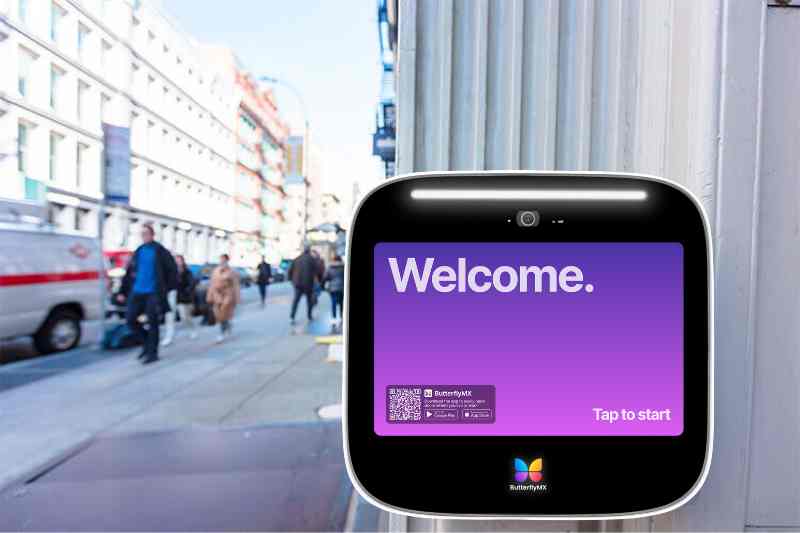
What are the four major types of door access control systems?
There is a wide range of door entry systems. They can be as simple as the traditional lock-and-key method or as technologically advanced as a cloud-based intercom system. The type of door access control system you should choose depends on your building’s unique needs and infrastructure.
Common types of door access systems include:
- Cloud-based access control system
- Network access control system
- Standalone access control
- Mobile-based access control
Cloud-based access control system
A cloud-based access control system uses the internet to store data and enables you to manage the system remotely through an online dashboard or mobile app.
Thanks to the cloud, these access control systems are easier and cheaper to install. You don’t have to run extensive wiring or install large on-site servers throughout your building. Moreover, cloud-based systems are easier to maintain. You don’t need to hire a technician to come to your property and update the system.
Rather, the manufacturer deploys regular updates, which prolongs their lifespan and adds new features over time.
You can also expect more functionality from your cloud-based system since it often supports integrations with other software and internet-connected devices.
For instance, you can pair your access control system with security cameras to better capture access activity throughout the property. As a result, your security measures are more effective at protecting your property and are easier to manage.
Network access control system
Also known as “legacy systems,” network access control systems require an on-site server or computer to connect to the internet. One of the biggest advantages of modern network access control systems is their ability to manage both physical and logical access.
In other words, these systems can manage who can enter the building and use certain software on local computers. If your business could benefit from such an ability, these systems may be for you. However, network access control systems have drawbacks.
For instance, network access control is complex to implement and install, especially with large applications. Thus, your installation costs are higher, and maintaining them is a hassle. You can also expect fewer features than in cloud-based solutions. With a lack of functionality, it’s important that you weigh which type of solution is best suited for you.
Standalone access control
Next, standalone access control systems are designed for single doors or entryways without connecting to a more extensive system or network. These devices are individually programmed and have the simple functionality of managing access to a single door.
Standalone door access control systems are best suited for places far from an IT closet or network connection. Running wiring throughout the property isn’t ideal, so using one of these systems still allows you to manage access to the area.
Overall, a standalone access control system is cost-effective without the bells and whistles of cloud-based or network access control systems. They are simple to install and require little to no maintenance. However, managing access permissions requires more work, so consider these qualities when deciding on a door access control system.
Mobile-based access control
One of the biggest advantages of mobile-based access control is its convenience for property managers and tenants. There’s no need to replace lost keys or fobs—users simply download an app and receive digital credentials. Additionally, property managers can grant or revoke access remotely, reducing administrative workload.
Mobile access control also enhances security by eliminating the risks associated with physical credentials. For example, businesses and residential properties can issue time-limited access to visitors, delivery personnel, or maintenance staff, ensuring they only have entry when needed.
Comparing single-door vs. multi-door access control systems
Single-door or standalone access control systems are designed to secure a single entrance. These systems are meant to be used by smaller buildings and businesses that only need to manage access to a single door or a few doors that don’t need to be interconnected.
On the other hand, multi-door access control systems provide centralized access for multiple entryways throughout a property. As such, multi-door access control systems are suited for larger properties managing access to various areas, such as amenity spaces, offices, storage areas, and more.
Here is how single-door and multi-door access control systems compare:
Choosing the door access control system that works for your property
Since 2014, ButterflyMX has been installed in more than 15,000 buildings and garnered over 40,000 five-star reviews.
We are a leading cloud-based access control company that simplifies property access by enabling employees and tenants to use their smartphones as credentials. Our property-wide access control solutions make it easy for property managers and owners to manage access throughout their entire property from a single dashboard.
ButterflyMX Access Control features
- Supports multiple credentials. Unlike traditional door-entry access control systems, ButterflyMX supports numerous access credentials, allowing you to choose the one that best suits your property’s needs and meets your security requirements. Choose from our mobile app, key cards, fobs, or PIN codes.
- Integrations. ButterflyMX supports various third-party integrations, ranging from smart locks and security cameras to property management systems. In turn, you can manage all of your most important property software and hardware in one place, streamlining workflows and cutting down on time.
- Offline mode. If your internet goes down, no problem. The ButterflyMX Access Control System continues to operate normally when the internet is down, ensuring your property remains secure. Our system will also work when the power goes out as long as it’s connected to a backup battery.
- Audit trail. Have peace of mind knowing our Access Control logs every door entry event in a detailed report. The audit trail features time- and date-stamped photos or videos (if paired with our Security Cameras). Not to mention, your system will include detailed information, such as the credentials used and who entered, giving you insight into how people use the access control system.
- Unified platform. Above all, ButterflyMX’s Access Control System seamlessly works alongside all our other products, creating a unified access and security platform. Integrate our Access Control System with Video Intercoms, Elevator Controls, Vehicle Access Control, Smart Locks, Security Cameras, and more.
Door access control FAQs
Before you decide on whether a door access control system is right for you, here are a few frequently asked questions that can provide you some more insight.
Some FAQs include:
- What is the difference between smart locks and access control?
- What is an access control door controller?
- Are number pad door locks safe?
- How much does an access control system cost per door?
- What is the difference between door entry and access control?
What is the difference between smart locks and access control?
Smart locks are different from access control in that they only manage access to a single area, such as an amenity space or apartment. On the other hand, access control is deployed throughout an entire property, encompassing multiple entryways via various hardware.
Of course, smart locks and access control differ in other ways:
What is an access control door controller?
An access control door controller is the mechanism that tells the door lock to release after the person’s credentials are verified. The door controller connects to the reader, which can be in the form of electronic keypads, RFID readers, or another type of system that uses WiFi, near-field connection (NFC), or Bluetooth connectivity.
Are number pad door locks safe?
Yes, number pad door locks are safe. However, you might run into problems around the code itself, like a resident forgetting a code or an old security code left in your system that poses a security risk.
To ensure security on your property, you can choose a system with guest code capabilities. That way, you can count on the PIN code automatically expiring so that a guest can’t use that code to get unauthorized access to the property later.
How much does an access control system cost per door?
The cost of an access control system per door varies based on the type of system, features, and installation requirements. You can expect to pay between $500 and $2,500 per door.
Here’s a breakdown of the costs:
- Basic standalone access control: $500 – $1,500 per door.
- Cloud-based or mobile access control: $1,000 – $2,500 per door (includes cloud management, mobile app access, and integration capabilities).
- Biometric or high-security access control: $2,000+ per door (includes fingerprint scanners, facial recognition, or advanced multi-factor authentication).
What is the difference between door entry and access control?
While both door entry and access control systems manage property access, they serve different purposes.
Door entry systems focus on visitor management and typically include intercoms or keypads that allow guests to request access or enter a PIN code.
Access control systems are designed for authorized personnel and regulate access for tenants, employees, or residents using credentials like keycards, fobs, or mobile apps.

Learn more about ButterflyMX
Fill in the form below, and we'll email you right back.
Have questions?
Fill in the form below, and we'll email you right back.






